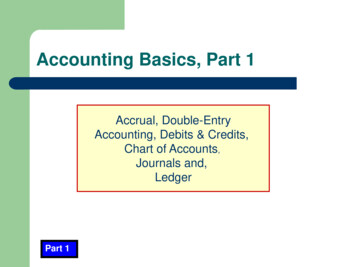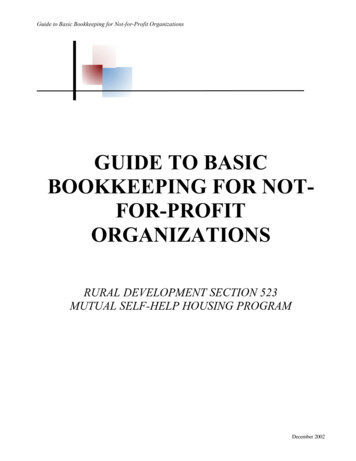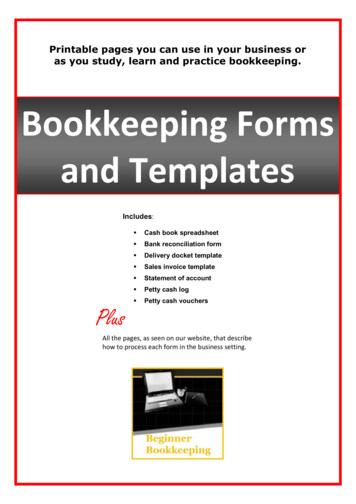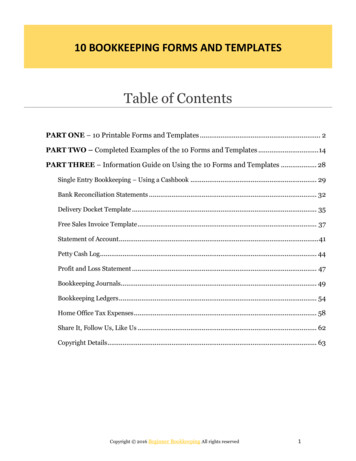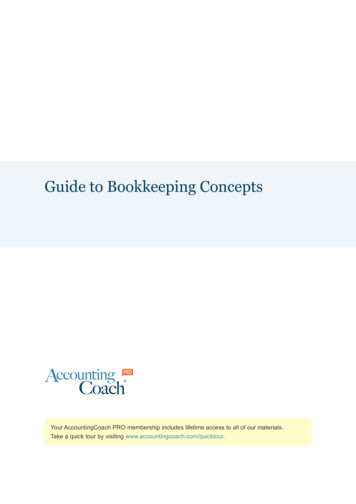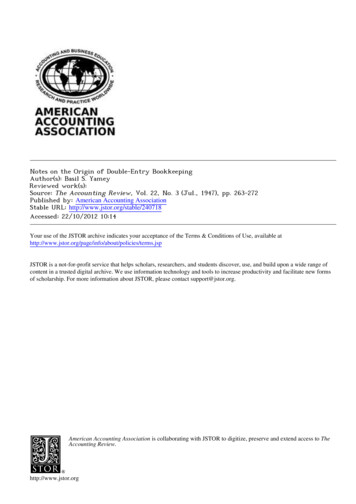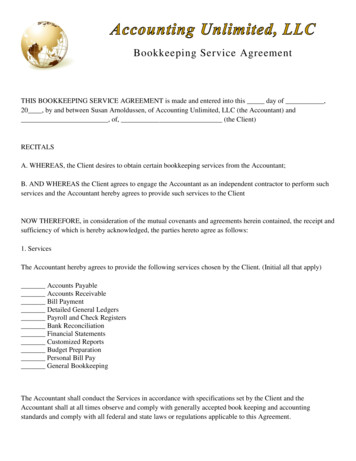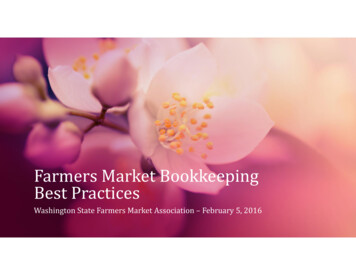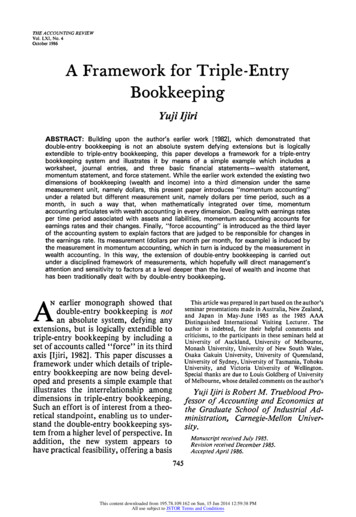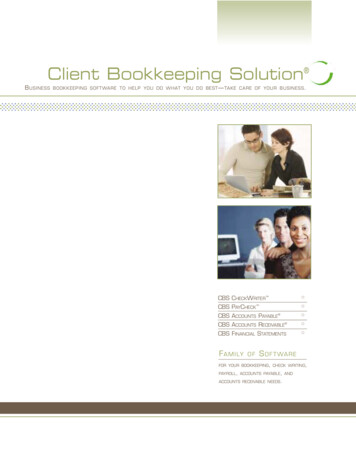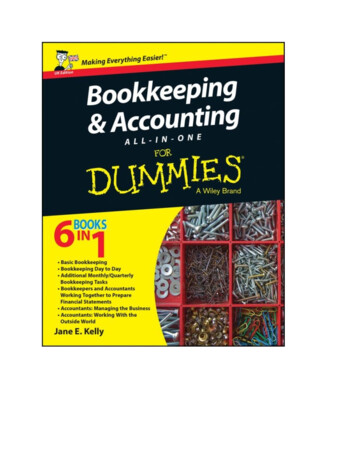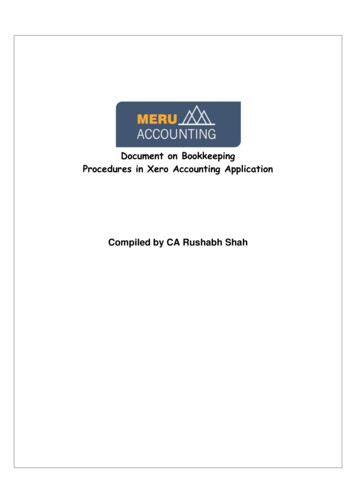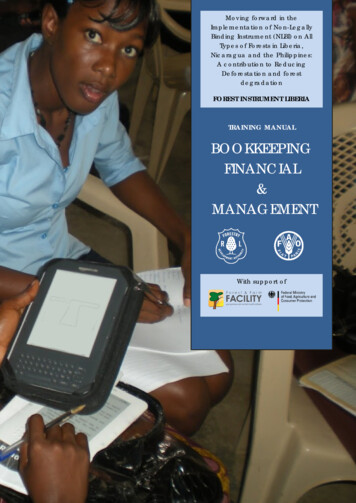
Transcription
Moving forward in theImplementation of Non-LegallyBinding Instrument (NLBI) on AllTypes of Forests in Liberia,Nicaragua and the Philippines:A contribution to ReducingDeforestation and forestdegradationFOREST INSTRUMENT LIBERIATRAINING MANUALBOOKKEEPINGFINANCIAL&MANAGEMENTWith support of
The views expressed in this information product are those of the author(s) and do notnecessarily reflect the views of BMELV, FAO, FDA, FFF.April 2013ii
AcknowledgementThis manual has been developed by Avril Fortuin. This document would not have beenpossible without the valuable contributions from different people working during thedevelopment and delivery of the training of trainers in the field. Sormongar Zwuen,National NLBI project coordinator and Joseph Boiwu. FAO Representative Operationsassistant, made contributions for assessment and implementation of the Manual.Important technical assistance was received from Jhony Zapata, FAO/FFF Rome, MarcoBoscolo, Sophie Grouwels and Fred Kaffero, FAO Rome made valuable contributions toimprove the structure and content of the publication and Marco Perri FAO/FFF for thelayout and formatting.Sincerest gratitude goes to Ms. Eva Muller Director, Forest Economics, Policy and ProductsDivision, FAO for her leadership and strategic guidance. Special recognition goes to theFederal Ministry of Food, Agriculture and Consumer Protection (BMELV) of Germany forthe financial support provided."iii
PrefaceIn May 2007, the National Forum on Forests (UNFF) adopted the Non-Legally BindingInstrument on All Types of Forest (NLB), which is commonly called the “Forest Instrument”. Thissignificant international consensus was reached to strengthen the implementation ofsustainable forest management (SFM), and thus to maintain and enhance the economic andenvironmental values of all types of forests, for the benefit of current and future generation.Most specifically, the Forest Instrument is to: () Strengthen political commitment and actions atall levels to implement effectively SFM, (ii) Enhance the contribution of forests to theachievement of the international agreed development goals including the MDG, and (iii)Provide a framework for national action and international cooperation.The overall objective of the project is “to support Liberia, Nicaragua and the Philippines, on ademonstration basis, to move forward in the implementation of the Non-Legally BindingInstrument on all types of forest”.The resources of any country are the lifeblood of that nation. The management of suchresources that will impact the beneficiaries is a key propriety that must not be taken forgranted; as such it must be managed effectively. When resources are available, the peopleshould have entrepreneurial and financial management skills to manage them. Liberia’s forestsector is an economic sector that is providing benefits to the local communities throughinvestment in logging activities where communities get shares from these investments in theforest sector. Their share of funds provided by these logging companies has been used toimprove the communities. This bookkeeping and financial management guide are intendedto develop and improve the skills of two national and community based organizations knownas the County Forest Forum (CFF) and Community Forestry Development Committee (CFDC);these two organizations are charged with the responsibilities of managing the funds from theforest sector and also helping the local communities manage resources from the forestthrough entrepreneurship.To date the bookkeeping and financial management manual was implemented in Liberia aspart of a pilot program. Training was conducted in two counties: Margibi and River Gee. Atotal of 50 beneficiaries from the CFF and CFDC from all 15 counties in Liberia attended thetrainings in these two locations. Following the training a ToT workshop was held (in River Gee)to hone the skills further of the top beneficiaries. These ToTs implemented the manual on thelocal communities in three counties: Ganta, Maryland and River Cess.The idea of business is aimed at satisfying the needs of customers that lead to the increasedwealth of owners of the business in terms of profit making. This manual focuses on howentrepreneurial ideas help to improve the businesses. The following key elements are criticalfor the improvement of any business; environment of the business, the quality of servicesprovided to customers, product pricing on the market, separating business assets frompersonal assets and access to credit. With these elements combined with bookkeeping andfinancial management ideas, including the process of how you manage the money cominginto your business and money going out of your business.This bookkeeping and financial management manual have six modules that look at the basicconcepts of bookkeeping and financial management. The following modules in this manualare structured as follows:1.The Importance of Bookkeeping. This module highlights the forms of business,problems that are encountered by business owners, the ideas of entrepreneurshipiv
in business, understanding basic bookkeeping concepts and best practice inbookkeeping.2. Understanding Symbols in Bookkeeping. These modules basic idea is on symbolrecognition, drawing of symbols, symbols for money in and money out,understanding income and expenses.3. How to Keep Accounting Records. This module focuses on cash book entry; thevarious books to be kept for proper record keeping of your business activities,entry system in bookkeeping, single entry system, the double entry system; debitand credit, balance sheets, and operating assets and liabilities.4. Knowing How to Calculate Business Profit and Loss. This model develops the abilitycalculating income and expenses and profit and loss.5. Managing Business Cash and Accounts. This module explains managingaccounts, managing cash and credit/ loan.6. Financial Management. The final module concludes the manual with discussingthe financial controls and system, sources of finance, time value of money;present value, future value and annuities, procurement and evaluation, suppliersmanagement and financial planning.Those persons having been involved in the development, and testing of the contentmaterial are convinced that the whole exercise was helpful and has undoubtedlystrengthened the bookkeeping and financial management skills of the Liberianstakeholders. We sincerely hope that the training manual will assist the Liberianstakeholders to build their capacities.Jean-Alexandre ScagliaHarrison S. Karnwea,FAO Representative in LiberiaManaging Director a.i., FDAv
Table of ContentsAcknowledgement . iiiPreface . ivModule 1: The Importance of Bookkeeping . 1Module 2: The Use of Symbols in Bookkeeping . 10Module 3: How to Keep Accounting Records. 18Entry Systems in Bookkeeping . 19Module 4: How to Calculate Business Profit and Loss. 28Module 5: Managing Business Cash and Accounts . 35Managing Accounts. 35Module 6: Financial Management. 41vi
Module 1: The Importance of BookkeepingBackground information for the Facilitator Most micro and small scale entrepreneurs do not write down how much moneycomes in and how much goes out of their business. They keep everything in theirhead. As a result, they do not actually know how much money they are earning,how much they buy and sell on credit and how they could improve their business.Objectives After completing this section, participants will be able to:State what a business is all aboutKnow the different business ownerships, their advantages and disadvantagesUnderstand entrepreneurshipExplain the importance of bookkeeping in business operationRaise interest in the courseTime 8 hoursNumber of Participants A group preferably to include 10 to 15 persons, but it should not exceed 25participants. Larger groups make it extremely difficult for the facilitator to trackthe progress of individuals.Materials Flip charts, chalk or white board, markers, chalk and a cleaning ragExercise books, pens, pencils, rulers, erasers, calculators for all participantsArea suitable for writing and learningType of Participants CFDC, CFF Entrepreneurs such as retailers, wholesalers, farmers and manufacturersVillage leadersLESSONA.UNDERSTANDING BUSINESSWhat is a Business?Let the participants discuss the answers first, before giving suggestions. Any answerresembling the following is good. (Answer) All activities whereby you try to earn anincome on a regular basis are called businesses.A business (also known as enterprise or firm) is an organization which is engaged in thetrade of goods, services, or both to satisfy the consumers in order to make a profit.Businesses are predominant in capitalist economies, where most of them are privatelyowned and administered to earn profit to increase the wealth of their owners. Businessesmay also be not-for-profit or state-owned.1
Activity: 1Ask participants to list all the things and resources that are found in a business. This may includepeople, machinery, stationery, etc.Ask a volunteer to talk about his/her business they are operating. Let the volunteer explain to thegroup the products/ services he/she is selling.In a group discussion, let participants discuss what products/ services CFDC and CFF are engaged in.Also let them discuss some possible business opportunities they may engage with in the future.In what kind of business are you? (As a group and/or as an Individual)If your participants are working together in a co-operative business, invite individualparticipants to dicuss what additional income-generating activities they do at home.Business OwnershipOwnership forms related to micro, small and medium enterprises are: Sole proprietorship (owned by one person)Partnership (owned by a few persons, could be 2-20)Co-operative (owned by a large group)a) Sole Proprietorship/ Sole TraderIn this form of ownership, the whole business is owned by a single person.ooooThe owner enjoys all the profits of the business but also accepts all losses.This single owner has complete freedom to manage the affairs of thebusiness as he desires; he is answerable to nobody.The owner’s liability is unlimited. That is in settling the debts of the businessif the business assets are insufficient, the personal assets will also be taken.Being owned by a single person, the resources of the business are limited.b) PartnershipHere, two or more persons join to start a business.ooooooThe owners collectively are called the company, and individually,partners.The profits and losses are shared by the partners in agreed proportions.Their liability towards the firm’s debts is unlimited.Freedom of conducting the affairs of the business is restricted as thepartner is liable to the other partners.Since more than one person is involved, the resources of the firm areusually more.A partnership could also be formed to combine the resources required forthe enterprise. Resources could include skills, money, land, raw materialetc.2
Example:Flomo has money to buy palm nuts; Fatu has skills to produce palm oil.Flomo and Fatu can come together to form a partnership and create apalm oil processing business.c) Co-operative and Group OwnershipA co-operative is when people come together to do business with a commonpurpose and intent.oooooooIn a co-operative form of ownership, a large number of personscollectively own the enterprise and are involved in its activities. The partowners are called members.All the members contribute an equal amount towards capital, share theprofits equally and have equal rights.Since a large number of owners are involved, the management of the cooperative is entrusted to a small group of members who are elected bythe many.The financial asset is crucial. The liability of the members is limited.That is even if the assets of the co-operative are insufficient to satisfy thedebts, the members’ personal assets cannot be touched.A co-operative is also much more powerful than individuals orpartnerships.A co-operative represents a large group of people and, quite often, thisgives its access to Government programs and developmental agencies,which offer financial assistance in the form of grants or interest-free loans.A business owned by multiple individuals may be referred to as a company;although that term also has a more precise definition.Note: In these three categories of business ownership, it is essential to establishappropriate bookkeeping and financial management of the finances of these formsof business. Money coming in and money going out must be recorded in the variousbooks of the business for good management of record keeping.Activity: 2Ask participants to provide in a table format the advantages and disadvantages of the type of business theyare managing or would like to start.Divide participants into groups of five and let them discuss whether the CFDC and CFF are businesses. In thecontext of CFDC and CFF explain social enterprise and social entrepreneurship.After the exercise, distribute Handout 1.3
What Are YOU Encountering as Problems Within Your Own Business?In starting or operating a business, there
This bookkeeping and financial management manual have six modules that look at the basic concepts of bookkeeping and financial management. The following modules in this manual are structured as follows: 1. The Importance of Bookkeeping. This module highlights the forms of business, problems that are encountered by business owners, the ideas of entrepreneurship . v . in business, understanding .File Size: 1MBPage Count: 64
